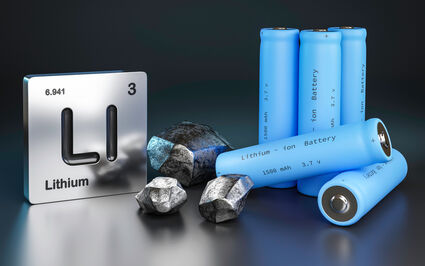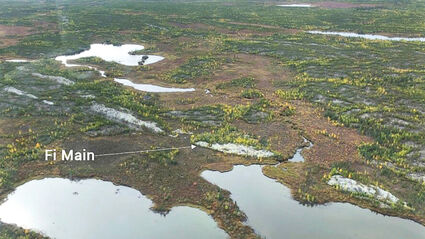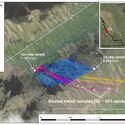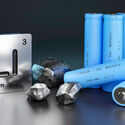Li-FT for Northwest Territories lithium
Exploration company acquires Yellowknife, host to potentially one of largest hard rock lithium resources in North America North of 60 Mining News – January 6, 2023
Last updated 1/5/2023 at 10:51am

Adobe Stock
Li-FT Power is a relatively new junior exploration company focused on Canadian projects with hardrock deposits of highly-demanded lithium for electric vehicle batteries.
Li-FT Power Ltd., a relatively new junior exploration company led by a team with a track record of discovering and financing mineral projects, has acquired an exciting hardrock lithium project that covers most of the Yellowknife Pegmatite Province in Northwest Territories.
The Yellowknife lithium project covers at least 14 pegmatites – igneous rocks with exceptionally large crystals that are the major source of hardrock lithium worldwide – on mineral leases that are 30 kilometers (19 miles) northeast and 60 kilometers (37 miles) east of the NWT capital that the project is named after.
Historical channel sampling of pegmatite outcrops that are clearly visible on satellite images have produced average grades from 1.1 to 1.59% lithium oxide over widths of seven to 40 meters. These lithium-bearing pegmatites can be traced on the surface for 100 to 1,800 meters along strike.
"The Yellowknife Lithium Project is a tremendous opportunity to consolidate numerous lithium pegmatites that have the potential to be one of the largest hard rock lithium resources in North America," said Li-FT Power CEO Francis MacDonald. "The project was held privately for 35 years without having any exploration work completed at a time when lithium was not an exciting commodity."
MacDonald, who is co-founder and former president of Kenorland Minerals Ltd., brings 15 years of mineral exploration experience to the Li-FT team, including nearly a decade of greenfield exploration with Newmont Corp.
He is joined by Li-FT Power President Alex Langer, an 18-year public market specialist that worked with Canaccord Genuity as an investment advisor for four years, where he helped fund over 100 companies in the technology, mining, healthcare, forestry, green technology, and other sectors.
Langer is credited for his integral role in the recent success of Millennial Lithium Corp., where as vice president he brought the development company key financial support and industry partners from his global connections.
Historic lithium province
The lithium-rich pegmatite field east of Yellowknife has been known for nearly 80 years, but until the rise of lithium-ion batteries in cordless electronics and now electric vehicles, the market for this lightest of all metals was miniscule.
Despite the limited markets, the size and grade of the pegmatites in this province attracted the attention of oil producers in the 1970s and 1980s, who were likely looking for lithium to add to grease and lubricants, one of the larger historical uses for the metal.
Pegmatites carrying spodumene, a lithium mineral, were first discovered in NWT's Yellowknife Pegmatite Province during the 1940s and intermittently explored through to the 1980s.
Canadian Superior Exploration Ltd. completed systematic mapping, spodumene crystal counts, blasting-trenching, channel sampling, and drilling in the province from 1975 to 1979.
Based on this work, the mineral exploration arm of Superior Oil estimated that the top 500 feet (152 meters) of the province hosted 49 million tons of pegmatite averaging 1.4% lithium oxide. Roughly 75% of this historical resource potential is found on the mineral leases that now make up Li-FT's Yellowknife project.
When Superior Oil was acquired by Mobil in 1984, the claims holding the largest lithium pegmatites were transferred to a private company that Li-FT has now acquired to gain full ownership.
In 1985, the private company entered into an option agreement with Equinox Resources Ltd., which carried out metallurgical testing on bulk samples collected in 1987. Given the positive results from this testing, Equinox recommended a full feasibility study but was acquired by Hecla Mining Company before any further work was completed, and the deposits reverted back to the private company.
Very little exploration work has been carried out on the lithium-rich properties over the ensuing 35 years.
Yellowknife lithium 2023
Li-FT plans to rectify the dearth of modern exploration in the Yellowknife Pegmatite Province and has closed a deal to acquire the private company that has held properties in this lithium-rich region for the better part of four decades.
Under the deal, Li-FT exchanged 18 million shares for all the shares of the longtime owner of the Yellowknife claims.
In addition to the Yellowknife Lithium Project, the private company acquired by Li-FT held the Cali lease in the Little Nahanni Pegmatite Field, which is in the Mackenzie Mountains in western NWT near the Yukon border, and roughly C$11.7 million in cash and cash equivalents.
With the cash already in its treasury, Li-FT now has C$17 million to advance Yellowknife and the other lithium projects in its portfolio.
"We are very happy to have completed the acquisition of the Yellowknife Lithium Project which is a transformative moment for Li-FT," said MacDonald.
In addition to being a potentially large source of near-surface lithium, the Yellowknife project enjoys the advantages of being close to infrastructure in a Canadian territory that is looking to leverage its critical minerals wealth.
"The breadth of our mineral potential is expanding even further, thanks to the presence of green economy metals like rare earth minerals, lithium, nickel, and cobalt needed to meet the demand of clean technologies along with many other resources recognized as critical or strategic minerals and metals," said Northwest Territories Minister of Industry, Tourism and Investment Caroline Wawzonek.
Many of the pegmatite outcrops in the Yellowknife Lithium Project can be accessed by roads that extend to the NWT capital and on to the northern end of Canada's rail network at Hay River, NWT.
Li-FT plans to initially focus its exploration on a group of road-accessible pegmatites that account for roughly 75% of the resource potential. Once it has established a modern industry-compliant resource and advanced these projects further up the value chain, the company will begin exploring the outlying pegmatites as satellite or potentially standalone deposits.
"We look forward to materially advancing the project in 2023," said MacDonald.
Beyond Yellowknife
In addition to Yellowknife, Li-FT's portfolio includes three greenfield lithium projects – Rupert, Pontax, and Moyenne – covering 2,282 square kilometers (881 square miles) in St. James, Quebec, and the Cali rare earths-lithium project.
The Rupert and Pontax are road-accessible, and Li-FT has already carried out sampling that has outlined large lithium anomalies on both properties.
With two large lithium anomalies at the drill-ready stage, Rupert is the most advanced of the Quebec properties.
"The size and tenor of Anomalies A and B suggests that additional lithium deposits similar in size to Whabouchi, Canada's largest hardrock lithium deposit, could be located on Li-FT's ground," MacDonald said upon reporting results from 2022 exploration at Rupert. "We look forward to diamond drill testing these targets in 2023, as well as moving other anomalies through the pipeline towards drill targeting next summer."
While Rupert is the most advanced, Pontax hosts the largest lithium anomaly on Li-FT's Quebec properties. Sampling by the company has outlined a lithium-rich geochemical anomaly that is roughly eight kilometers (five miles) long and 7.5 kilometers (4.7 miles) wide.

Li-FT Power Ltd.
White pegmatite dike outcrops at the Fi Main target of Li-FT Power's Yellowknife lithium project in Northwest Territories.
"The 60 square kilometers of lithium anomalism in till could represent a number of different things – it could be caused by lithium pegmatites concealed by glacial sediments or it could represent the signature of a fertile granite," said MacDonald. "We will pursue this anomaly during the next field season to determine if the results represent buried lithium pegmatite mineralization."
Up to 275 pegmatites have been noted over a 13- by 2.5-kilometer (8.1 by 1.6 miles) corridor of the Little Nahanni Pegmatite Field where Cali is located.
Canadian Superior Exploration mapped the Cali pegmatite in 1977 and described a 60-meter-wide spodumene pegmatite that outcropped over 500 meters along strike and has a vertical extent of 300 meters. Trench and sampling in the 1980s suggest this pegmatite, which has returned grades of 1.14% lithium oxide over 12 meters, could extend for another 700 meters under cover.
Li-FT is considering scout drilling to better understand the size potential at Cali.






















Reader Comments(0)